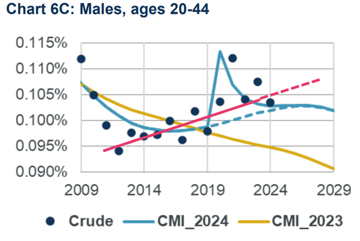Should projected longevity improvements be reduced at the oldest ages?
This content is AI generated, click here to find out more about Transpose™.
For terms of use click here.

In its latest proposal for the future of the CMI mortality projections model, the CMI have made great strides in improving the model with major updates to both the fit across different age ranges and the fit across the pandemic.
However, we believe that improvements to the methodology for applying age-period convergence at older ages could reduce life expectancies in the proposed core model by around 1%.
The improvement of the fit by age and how it fed into the projection of short-term mortality rates was a large focus of LCP’s response to the consultation. The proposed CMI_2024 model fits:
- an apparent upward trend in mortality rates at the youngest ages [1]; and
- an almost flat trend in mortality rates at the oldest ages over the last decade, better reflecting our own views
In our view there is more work to be done to use these trends to inform short-term mortality improvements for working ages and older pensioners. A change could be more material than many may realise.
We note that the CMI is currently considering the responses submitted to its consultation on CMI_2024 and the final model may differ from that proposed.
Age-period convergence to the long-term rate of improvement
Fundamentally, the CMI model looks for patterns in past rates of mortality improvements to form a view on what current rates of improvement are. From there, it trends to the long-term rate input by the user. This is a somewhat simplistic explanation ignoring the impacts of cohort and period effects etc.
The length of time that it takes for the projected mortality improvements to trend to the long-term rate is governed by the age-period and the cohort convergence terms. This blog focuses on the former. The longer the convergence term the more influential the current rates of improvement are, the shorter the term the more the long-term rate matters.
The current age-period convergence term in the core CMI model is shown in the chart below.
Age-period convergence term in the core CMI model
The original rationale for the age-period convergence term being shorter at the youngest and oldest ages is set out in CMI Working Paper 39 (published in July 2009). The age-period convergence was set to be shorter at younger/older ages to reflect the view that:
- For younger ages - “mortality improvements for younger adults have tended to change from decade to decade”.
- For older ages – “in keeping with the general concept of mortality improvement rates running to zero relatively quickly after age 100”.
Projected mortality rates at younger ages
We welcome the changes made to the age-period component that has resulted in a much closer fit to past data at younger ages (blue vs yellow line on Chart 6C from Working Paper 197 below).
However, the CMI model is now required to project from fitted mortality rates that are increasing over time.
We observe that for young males, the model appears to almost immediately revert to mortality improvements, despite the past decade showing worsening mortality. We have illustrated this idea on Chart 6C, with a pink line of where it might be reasonable to have expected the model to project Age-Standardised Mortality Rates (“ASMRs”) in the short term.

It is possible to model higher mortality rates in the short-term by extending the age-period convergence to the long-term rate at younger ages, so more weight is given to the current trend. Whilst we understand that the convergence period is short given the fluctuation of mortality rates at younger ages, it could be argued that given the significant analysis and model development carried out for CMI_2024, the CMI can now be more confident with the age-period and cohort effects identified and therefore do not require the model to converge to the long-term rate so quickly. However, we acknowledge that the ability to identify cohorts at younger ages remains hindered by the low and fluctuating number of deaths.
Alternatively, other levers in the CMI model could be explored such as more age-period terms or treatments of cohorts.
Projected mortality rates at the older ages
We understand that the CMI focused its analysis of older ages on the 75-100 age group (at least as illustrated in Working Paper 197).
When we viewed how the CMI_2024 model fitted to the 90-100 age group, we noticed that the fit by age was not as pleasing as it is for the wider 75-100 age group. As per the youngest ages, we found that the mortality improvements revert to the long-term rate almost immediately. However, over 2010-2019, there was only minimal mortality improvement for this age group.
Again, a possible solution to this could be to lengthen the age-period convergence to the long-term rate at older ages. By doing so, we are left with mortality rates that stay higher for longer.
For illustration, we have set out below the ASMRs for males aged 90-100 for the proposed CMI_2024 with and without the changes discussed above made to the age-period convergence [2]. All other parameter values are the same. As you can see, the near-term future projection is more similar to the low improvements witnessed over the previous decade.
Male ASMR over ages 90-100
What this means for life expectancies
You may wonder why we have taken the time to write a blog about such a niche aspect of the CMI model. The explanation is simple – it is material.
We have found that, if you were to keep the age-period convergence at older ages stable at 20 years, the changes in life expectancies are stark. At younger ages, life expectancies fall by around 1%. At older ages, the fall is even more pronounced. We have illustrated this change in the chart below.
Difference in life expectancy between proposed Core CMI_2024 and proposed CMI_2024 with longer old-age convergence
Note: ages below age 65 represent the difference in deferred life expectancies to age 65
Whether you are an insurer or a pension scheme, a fall in life expectancy of over 1% will have a material impact on your liabilities. In a world where we all need the best data to make the most optimal decisions, we think this is an area that should be considered.
[1] The CMI are reliant on ONS population data which is less accurate at ages most impacted by immigration.
[2] We have illustrated keeping the age-period convergence at 20 years at all older ages.
Subscribe to our thinking
Get relevant insights, leading perspectives and event invitations delivered right to your inbox.
Get started to select your preferences.





